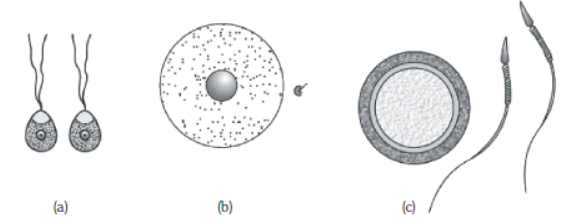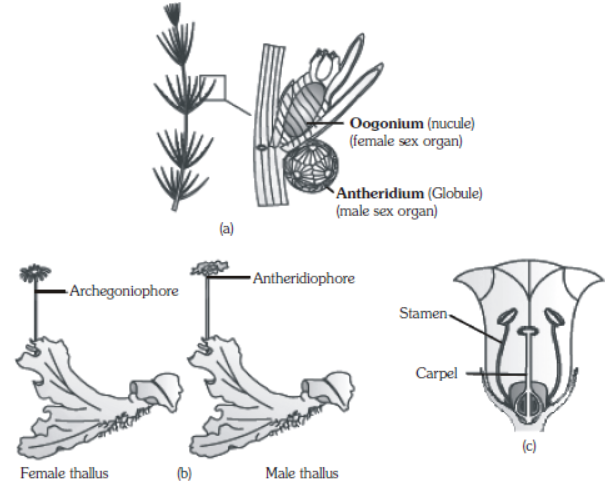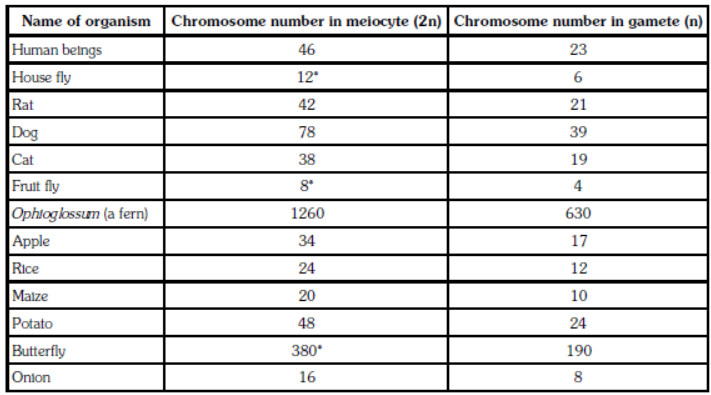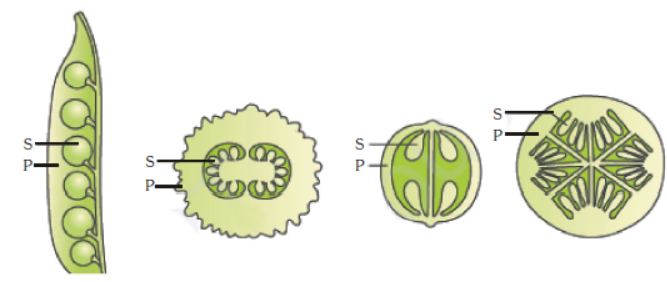Please refer to the Reproduction in Organisms Notes Class 12 Biology given below. These revision notes have been designed as per the latest NCERT, CBSE, and KVS books issued for the current academic year. Students will be able to understand the entire chapter in your class 12th Biology book. We have provided chapter-wise Notes for Class 12 Biology as per the latest examination pattern.
Revision Notes Chapter 1 Reproduction in Organisms Class 12 Biology
Students of Class 12 Biology will be able to revise the entire chapter and also learn all important concepts based on the topic-wise notes given below. Our best teachers for Grade 12 have prepared these to help you get better marks in upcoming examinations. These revision notes cover all important topics given in this chapter.
• The period from birth to the natural death of an organism represents its life span.
Life spans of organisms are not necessarily correlated with their sizes; the sizes of crows and parrots are not very different yet their life spans show a wide difference.
Similarly, a mango tree has a much shorter life span as compared to a peepal tree. Whatever be the life span,death of every individual organism is a certainty, i.e., no individual is immortal, except single-celled organisms.

• Reproduction is defined as a biological process in which an organism gives rise to young ones (offspring) similar to itself. The offspring grow, mature and in turn produce new offspring. Thus, there is a cycle of birth, growth and death.
Reproduction enables the continuity of the species, generation after generation.
• The organism’s habitat, its internal physiology and several other factors are collectively responsible for how it reproduces.
When offspring is produced by a single parent with or without the involvement of gamete formation, the reproduction is asexual. When two parents (opposite sex) participate in the reproductive process and also involve fusion of male and female gametes, it is called sexual reproduction.
ASEXUAL REPRODUCTION
• In this method, a single individual (parent) is capable of producing offspring. As a result, the offspring that are produced are not only identical to one another but are also exact copies of their parent.
• Are these offspring likely to be genetically identical or different? Answer will be genetically identical.
• The term clone is used to morphologically and genetically similar individuals
• Many single-celled organisms (monerans and protists) reproduce by binary fission.
• Member of kingdom fungi and algae reproduce through special asexual reproductive structures called zoospores.
• Conidia (Penicillum) buds (Hydra) and gemmules (sponge) are other common asexual reprodutive structures.

Vegetative propagules in angiosperms : (a) Eyes of potato; (b) Rhizome of ginger;
(c) Bulbil of Agave; (d) Leaf buds of Bryophyllum; (e) Offset of water hyacinth (Eichhornia)
• The fleshy bud which produces new plants in hydrophytes is called Turion.
• Is vegetative reproduction also a type of asexual reproduction? Answer will be yes.
• Is the term clone applicable to the offspring formed by vegetative reproduction? Answer will be yes.
• While in animals and other simple organisms the term asexual is used unambiguously, in plants, the term vegetative reproduction is frequently used.
• In plants, the units of vegetative propagation such as runner, rhizome, sucker, tuber, offset, bulb are all capable of giving rise to new offspring. These structures are called vegetative propagules.
• ‘Water hyacinth’ (Terror of Bengal) which is one of the most invasive weeds found growing wherever there is standing water. It drains oxygen from the water, which leads to death of fishes.
• This plant was introduced in India because of its beautiful flowers and shape of leaves. Since it can propagate vegetatively at a phenomenal rate and spread all over the water body in a short period of time, it is very difficult to get rid off them.
SEXUAL REPRODUCTION
• Sexual reproduction involves formation of the male and female gametes, either by the same individual or by different individuals of the opposite sex. These gametes fuse to form the zygote which develops to form the new organism. It is an elaborate, complex and slow process as compared to asexual reproduction.
• Because of the fusion of male and female gametes, sexual reproduction results in offspring that are not identical to the parents or amongst themselves.
• A study of diverse organisms’plants, animals or fungi’show that though they differ so greatly in external morphology, internal structure and physiology, when it comes to sexual mode of reproduction, surprisingly, they share a similar pattern. Let us first discuss what features are common to these diverse organisms.
• All organisms have to reach a certain stage of growth and maturity in their life, before they can reproduce sexually.
That period of growth is called the Juvenile phase. It is known as vegetative phase in plants. This phase is of variable durations in different organisms.
• In some plants, where flowering occurs more than once, what would you call the inter-flowering period ‘ juvenile or mature? Answer will be mature.
• Plants’the annual and biennial types, show clear cut vegetative, reproductive and senescent phases, but in the perennial species it is very difficult to clearly define these phases.
• A few plants exhibit unusual flowering phenomenon; some of them such as bamboo species flower only once in their life time, generally after 50-100 years, produce large number of fruits and die.
• Another plant, Strobilanthus kunthiana (neelakuranji), flowers once in 12 years. As many of you would know, this plant flowered during September-October 2006. Its mass flowering transformed large tracks of hilly areas in Kerala, Karnataka and Tamil Nadu into blue stretches and attracted a large number of tourists.
• The end of reproductive phase can be considered as one of the parameters of senescence or old age.
• There are concomitant changes in the body (like slowing of metabolism, etc.) during this last phase of life span. Old age ultimately leads to death.
• In both plants and animals, hormones are responsible for the transitions between the three phases.
Interaction between hormones and certain environmental factors regulate the reproductive processes and the associated behavioural expressions of organisms.
• Events in sexual reproduction : After attainment of maturity, all sexually reproducing organisms exhibit events and processes that have remarkable fundamental similarity, even though the structures associated with sexual reproduction are indeed very different.
• The events of sexual reproduction though elaborate and complex, follow a regular sequence.
• PRE-FERTILISATION EVENTS
Gametogenesis
Gamete transfer
• Gametogenesis
Gametogenesis refers to the process of formation of the two types of gametes ‘ male and female. Gametes are haploid cells.
• In some algae the two gametes are so similar in appearance that it is not possible to categorise them into male and female gametes.
• They are hence called homogametes (isogametes). However, in a majority of sexually reproducing organisms the gametes produced are of two morphologically distinct types (heterogametes).

Types of gametes: (a) Isogametes of Cladophora (an alga); (b) Heterogametes of Fucus (an alga);
(c) Heterogametes of Homo sapiens (Human beings)
•Sexual reproduction in organisms generally involves the fusion of gametes from two different individuals. But this is not always true.
•In several fungi and plants, terms such as homothallic and monoecious are used to denote the bisexual condition and heterothallic and dioecious are the terms used to describe unisexual condition.
• In flowering plants, the unisexual male flower is staminate, i.e., bearing stamens, while the female is pistillate or bearing pistils.
• In some flowering plants, both male and female flowers may be present on the same individual (monoecious) or on separate individuals (dioecious).
•Some examples of monoecious plants are cucurbits and coconuts and of dioecious plants are papaya and date palm.
Special point :-
• A haploid parent produces gametes by mitotic division.
• Several organisms belonging to monera, fungi, algae and bryophytes have haploid plant body, but in organisms
belonging to pteridophytes, gymnosperms, angiosperms and most of the animals including human beings, the parental body is diploid.

Diversity of sexuality in organisms (a) Monoecious plant (Chara);
(b) Dioecious plant (Marchantia); (c) Bisexual flower (sweet potato)
Table : Chromosome Numbers in Meiocytes (diploid, 2n) and Gametes (haploid, n) of Some Organisms.

Gamete transfer :
• In a majority of organisms, male gamete is motile and the female gamete is stationary.
• In angiosperms and in red algae both male and female gametes are non-motile.
• In several simple plants like algae, bryophytes and pteridophytes, water is the medium through which this gamete transfer takes place. A large number of the male gametes, however, fail to reach the female gametes.
To compensate this loss of male gametes during transport, the number of male gametes produced is several thousand times the number of female gametes.
• In bisexual, self-fertilising plants, e.g., peas, transfer of pollen grains to the stigma is relatively easy as anthers and stigma are located close to each other; pollen grains soon after they are shed, come in contact with the stigma. But in cross pollinating plants (including dioecious plants), a specialised event called pollination facilitates transfer of pollen grains to the stigma. Pollen grains germinate on the stigma and the pollen tubes carrying the male gametes reach the ovule and discharge male gametes near the egg.
FERTILISATION
• The most vital event of sexual reproduction is perhaps the fusion of gametes. This process called syngamy results in the formation of a diploid zygote. The term fertilisation is also often used for this process. The terms syngamy and fertilisation are frequently used though, interchangeably.
• Where does syngamy occur? In most aquatic organisms, such as a majority of algae and fishes as well as amphibians, syngamy occurs in the external medium (water), i.e., outside the body of the organism. This type of gametic fusion is called external fertilisation.
• In many terrestrial organisms, belonging to fungi, higher animals such as reptiles, birds, mammals and in a majority of plants (bryophytes, pteridophytes, gymnosperms and angiosperms), syngamy occurs inside the body of the organism, hence the process is called internal fertilisation. In all these organisms, egg is formed inside the female body where they fuse with the male gamete.
• In organisms (eg. bryophytes and pteriodphytes) exhibiting internal fertilisation, the male gamete is motile and has to reach the egg in order to fuse with it. In these even though the number of sperms produced is very large, there is a significant reduction in the number of eggs produced.
• In seed plants, however, the non-motile male gametes are carried to non-motile female gamete by pollen tubes.
• The female gamete undergoes development to form new organism without fertilisation this phenomenon is called parthenogenesis.
POST FERTILIZATION EVENTS :-
Events in sexual reproduction after the formation of zygote are called post fertilization events.
The Zygote :-
• Formation of the diploid zygote is universal in all sexually reproducing organisms. In organisms with external fertilisation, zygote is formed in the external medium (usually water), whereas in those exhibiting internal fertilisation, zygote is formed inside the body of the organism.
• In organisms belonging to fungi and algae, zygote develops a thick wall that is resistant to dessication and damage. It undergoes a period of rest before germination.
• Zygote is the vital link that ensures continuity of species between organisms of one generation and the next.
EMBRYOGENESIS
•Embryogenesis refers to the process of development of embryo from the zygote. During embryogenesis,
zygote undergoes cell division (mitosis) and cell differentiation. While cell divisions increase the number of cells in the developing embryo; cell differentiation helps groups of cells to undergo certain modifications to form specialised tissues and organs to form an organism.
•In flowering plants, the zygote is formed inside the ovule. After fertilisation the sepals, petals and stamens of the flower wither and fall off. The pistil however, remain attached to the plant. The zygote develops into the embryo and the ovules develop into the seed. The ovary develops into the fruit.

A few kinds of fruit showing seeds (S) and protective pericarp(P)

